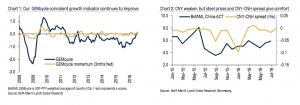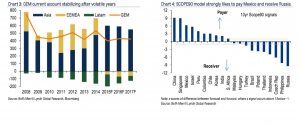BoAML| After the break we maintain our pre-summer positivity on EM and think an EM bubble is highly possible by next year given DM policies and improving EM fundamentals. Our GEMcycle coincident activity indicator continues to improve the last reading even did in each of the ten markets (Chart 1). According to our latest global GDP forecasts EM growth is still likely to continue to improve vs DM during 2016– as long as it remains orderly is ultimately positive for EM growth: our China Activity Coincident Tracker (China-ACT) rose to 5.9% yoy in July from a revised reading of 5.5% in June (Chart 2). Moreover, our BofAML commodity strategy team maintains a constructive view on Brent at $52/bbl in 4Q and $61 in 2017.
In the short-term we expect the consolidation that started in mid-August to continue through most of September and potentially turn into a more significant correction. The relentless inflow of the past two months is showing signs of exhaustion, and we feel that our positive EM call has now become widespread consensus. The G-20 summit on September 3-5 is unlikely to have much market impact. However, the ECB and Fed on September 8 and 21, respectively, could weigh on EM if they are not as dovish as expected: in fact, our economists expect the ECB to fail to deliver details on more QE. But the best candidate for a spike in volatility appears to be any unwind of the highly crowded flattener trade in core rates: watch US ISM and payrolls on September 1-2 and the OPEC meeting on September 26-28 in case it brings a rally in oil prices.
All eyes on currencies
Valuations across EM asset classes are not yet expensive – especially if considered relative to DM fixed income. Our FX Compass model continues to show an average undervaluation of 2% for the liquid currencies (Table 30on page 133). In equities, price/book for EM at about 1.5 remains about 50bp cheaper than DM too. In fixed income, spreads are at the lowest levels since the 2014 collapse in oil prices but still about 50bp off the 2013 lows in both our hard and local currency sovereign indices. However, this does not leave much cushion in case of a pickup in core rates volatility and makes thus us somewhat cautious in the near term.
Even more than usual FX is likely to be the bellwether for EM over the next 3-6 months: our bias is positive, and we would buy dips in EM local currency assets. Even in the face of Fed hikes, easy ECB policies as well as an improving EM vs DM current account differential (Chart 3) are likely to underpin EM currencies. Moreover, the recovery in commodity prices and domestic demand in Asia bodes well for reflation in some of the most undervalued currencies in Central Eastern Europe as well as Asia.
Trades: less direction, more selection
Our recommendations have become more mixed in direction, reflecting the impact of the EM rally of the past several months on valuations. In FX, we maintain our longstanding short CNH recommendations against USD and a basket of currencies (USD, EUR, JPY, AUD, MYR). We are also short CLP and IDR. In contrast, we are long MXN (vs a LatAm basket and EUR) and PLN (vs HUF and USD).
In rates our tactical rates trading signal SCOPE90 currently sends a fair balance of payer and receiver recommendations, again reflecting the lack of uniform direction (Chart 4). We have recently taken off two of our longstanding receiver recommendations: in Russia as fiscal policy seems to be turning more stimulative; and in South Africa as we envisage higher political volatility and uncertainty around the investment grade rating.
Still, we overall hold a receiving bias in these markets as well as across most higher- yielding EM, including active recommendations in Brazil and Indonesia. However, we like to hedge this with payers in low-yielding markets such as Poland and Singapore.
In sovereign credit, our top long convictions are in the three major high yielders: we remain long Argentina 2026s and Ukraine GDP-warrants. In Venezuela we are long the 19s vs the 20s.







